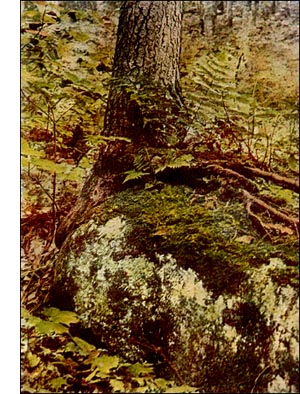Gymnostomum Curvirostrum Moss
 Habit and habitat.-This moss is found on limestone rocks and on deposits of carbonate of lime about springs and streams. The plants obtain the carbonic acid gas (CO2) which they need, from bicarbonate of lime which is dissolved in the surrounding water. By decomposition of the bicarbonate of lime [H2 Ca (CO3)2], which is soluble in water, the monocarbonate of lime (Ca CO3), which is insoluble in water is precipitated in the form of incrustations upon the leaves and stems of the moss, so that in time a very appreciable deposit of limestone is made.
Habit and habitat.-This moss is found on limestone rocks and on deposits of carbonate of lime about springs and streams. The plants obtain the carbonic acid gas (CO2) which they need, from bicarbonate of lime which is dissolved in the surrounding water. By decomposition of the bicarbonate of lime [H2 Ca (CO3)2], which is soluble in water, the monocarbonate of lime (Ca CO3), which is insoluble in water is precipitated in the form of incrustations upon the leaves and stems of the moss, so that in time a very appreciable deposit of limestone is made.Name.-From the Latin curvus, curved, and rostrum, a beak.
Plants (gametophyte).-Dark red or brown, matted, stems 2 to 5 inches long ; branches of equal height, in close clusters, covered with a felt of red radicles.
Leaves.-Spreading, slightly incurved when dry, pointed, lance-shaped, keeled, smooth, or with tiny projections ; base transparent ; margin entire or slightly serrate and recurved above the base ; vein vanishing below the apex.
Habit of flowering.-Male and female flowers on separate plants (dioicous).
Veil (calyptra).-Split up one side.
Spore-case.-Eggshaped, oblong, or nearly spherical, thick-walled, chestnut colour, shining, top-shaped when dry and empty.
Pedicel.- 1/6 to 2/6 of an inch long.
Lid (operculum).-With a long oblique beak, at base attached to a central column (columella) in the spore-case, by which it is held long after it has split away from the rim.
Annulus.-Two rows of persistent cells.
Spores.-Mature in late summer.
Distribution.-Common in North America, Europe, and Asia.
Very abundant in Niagara Falls.